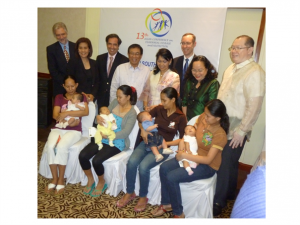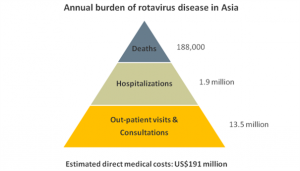NEWS AND UPDATES
The Philippines will begin vaccinating children against rotavirus in 2012
First Southeast Asian nation to implement WHO 2009 recommendation
Another rotavirus vaccine milestone was reached today, as the Philippines became the first country in Southeast Asia to implement the World Health Organization’s (WHO) recommendation to introduce life-saving rotavirus vaccines through its national immunization program. Rotavirus diarrhea exacts an enormous toll on the health of young Filipino children and the nation’s healthcare resources:
- An estimated 3,500 children under age five die from rotavirus diarrhea annually (12% of all diarrheal deaths).
- 77% of children are infected with severe rotavirus before their second birthday.
- 31% of young child diarrhea-related hospitalizations are due to rotavirus.
- 30% of young child diarrhea-related emergency room visits are due to rotavirus.
Â
During the 13th Asian Conference on Diarrheal Disease and Nutrition (ASCODD) in Manila, Health Secretary Enrique T. Ona announced that the Philippines will introduce rotavirus vaccines with an initial focus on children living in the poorest communities, which have the highest child morbidity and mortality rates from diarrheal diseases.

Â
Asia bears a staggering burden of rotavirus disease. 42% of the 435,000 annual global rotavirus-related deaths occur in Asia. According to WHO 2010 surveillance estimates, 45% of Asian children hospitalized for diarrhea test positive for rotavirus.

Â
The demonstrated health and economic burden of rotavirus in Asia is substantial, and recent studies have shown that rotavirus vaccination can be cost-effective in Asia. However, countries in the region have not introduced rotavirus vaccines into their national immuization programs. This reluctance is due in part to the uncertainty regarding the cost to purchase vaccines. While there are a number of GAVI-eligible countries in Asia , the Philippines and many other countries in the region are lower-middle and middle-income countries and are therefore not eligible to apply to GAVI for co-financing for vaccine introduction.
In Latin America, the Pan American Health Organization (PAHO) has developed a revolving fund to pool resources of countries to negotiate for lower vaccine prices. At ASCODD, rotavirus technical experts discussed strategies to increase the accessibility, availability, and affordability of rotavirus vaccines in Asia, including a potential regional cost-sharing model similar in concept to the PAHO Revolving Fund.
Rapid and remarkable reductions in hospitalization and deaths due to rotavirus and all-cause diarrhea have been observed in many of the 30 countries that have introduced rotavirus vaccines into their national immunization programs. The decline of severe and fatal diarrhea following the introduction of rotavirus vaccines underscores the incredible potential for rotavirus vaccines to save children’s lives in Asia and around the world. We hope that the announcment by the Philippines will encourage other Asian countries to intensify their efforts towards national introduction of rotavirus vaccines.
Â
Â
PATH collaborates on rotavirus vaccine activities with the CDC, WHO, UNICEF, vaccine manufacturers, and countries around the world. RotaFlash is funded by the GAVI Alliance.
For information on rotavirus disease and RotaFlash, please email us. For information on diarrheal disease, please visit DefeatDD’s website. For information on the GAVI Alliance’s support for rotavirus vaccine introduction, please click here.
Banner photo courtesy of One: Living Proof.
Other photo:
Bernd Benninghoff, GlaxoSmithKline. 13th Asian Conference on Diarrheal Disease and Nutrition (ASCODD): Tagatay City, The Philippines.
Sources for Figure:
Tate JE et. al. 2008 estimate of worldwide rotavirus-associated mortality in children younger than 5 years before the introduction of universal rotavirus vaccination programmes: a systematic review and meta-analysis. The Lancet Infectious Diseases. In press.
Abstract available here.
Podewils LJ et al. Projected cost-effectiveness of rotavirus vaccination for children in Asia. Journal of Infectious Disease. 2005; 192(Sup 1):S133–45.




